Science
The desperate hours: a pro baseball pitcher's fentanyl overdose

Not many victims of the opioid crisis in America make national headlines. Tyler Skaggs was different.
The 27-year-old was a professional athlete, a pitcher for the Angels, wealthy and famous. On a road trip with the team, he was found in his hotel room. He had choked on his own vomit after consuming a mix of alcohol, oxycodone and fentanyl.
His death on July 1, 2019, sent shock waves through the sports world. A highly publicized criminal investigation not only revealed that Skaggs had secretly used painkillers for years, but also led to the arrest of a team employee accused of providing him with tainted, black market pills.
Five years later, The Times has pored over hundreds of pages of court documents and cellphone records to reconstruct Skaggs’ final hours. Playing cards with teammates on a three-hour flight. Teasing rookies on the bus. Trading affectionate texts with his wife until late at night.
Even the most ordinary details tell an important story, offering an intimate look at an epidemic that has ravaged the country.

Tyler Skaggs pitches against the Oakland Athletics on June 29, 2019, two days before his death.
(Marcio Jose Sanchez / Associated Press)
Skaggs pitches at Angel Stadium against the Oakland A’s and is pulled after surrendering two runs in four-plus innings. CAA agent Nez Balelo texts to commiserate about “the quick hook … after cruising basically through 3 and 4.”
Skaggs is nothing if not dogged. At 6 feet 4 and 225 pounds, he has fought back from a string of serious injuries, refusing to quit, which might help explain his painkiller use. After the game, his mother, Debbie Hetman, a longtime softball coach at Santa Monica High, calls him and his wife.
“I didn’t FaceTime him because I was – we were super busy, so we just talked really quickly,” Hetman later testifies during the team employee’s trial. “I think he was in line at In-N-Out with Carli.”
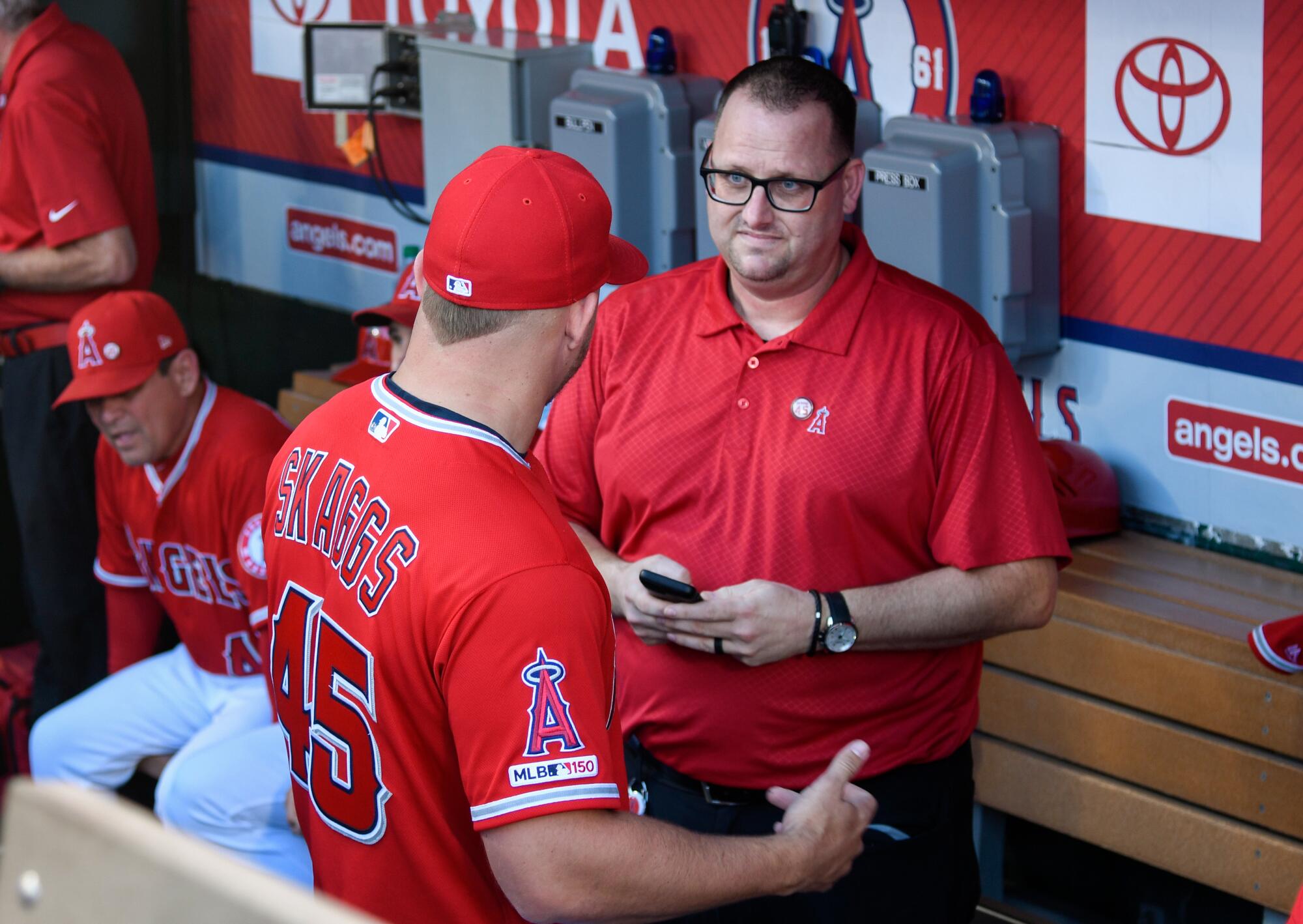
Mike Trout, wearing Tyler Skaggs’ number in his honor, speaks to Eric Kay in the dugout before a July, 12, 2019, home game against the Seattle Mariners.
( John McCoy / Getty Images)

(Animation by Kelvin Kuo/Los Angeles Times)
Shortly before a 1:07 p.m. game against the A’s, Skaggs receives a text from Eric Kay, the team communications director who for years has allegedly supplied him with “blue boys” — blue, 30-milligram oxycodone pills.
Kay: “Hoe [sic] many?”
Skaggs: “Just a few like 5”
Kay: “Word”
Skaggs: “Don’t need many”

4:25 p.m. Pacific Time
The Angels conclude their four-game home series with a 12-3 loss. It is a get-away day, meaning the team will head directly from the stadium to Long Beach Airport, where a charter plane waits for the start of the road trip.
Skaggs has previously asked his manager’s permission for the players to dress like cowboys for the flight to Texas. Before leaving the stadium, he meets his wife, Carli, so she can snap pictures of him in his black hat, bolo tie and boots.
“When did he buy that outfit?” a prosecutor later asks her during Kay’s trial.
“The day before.”
“Did you help him pick it out?”
“Yes.”
6:11 p.m. PT
Skaggs gathers with teammates on the tarmac beside a United Airlines charter plane for another photo to show off their Western wear. He hitches his thumbs in his belt like a cowboy. Seeing the picture on Instagram, Carli comments: “So cute”
8:07 p.m. PT
(Animation by Kelvin Kuo/Los Angeles Times)
With the Texas Rangers next on the schedule, the flight to Dallas Fort Worth International Airport lasts about three hours. Along the way, Carli texts to ask how things are going.
Skaggs: “Good gambling … losing”
Carli: “Damn babe … How much cool … Lol*”
Skaggs: “200 bucks … I’m winning now”
Carli: “Sweet”

11:06 p.m. Central Time
On the 15-minute ride from the airport to a Dallas-area hotel, Skaggs grabs a microphone at the front of the bus.
“So, he would have been kind of like emceeing, doing the music,” teammate Andrew Heaney later testifies. “You know, we would call younger guys up, ask them, you know, embarrassing questions or make them tell a funny story or whatever it may be, make them sing a song, something like that.”
Throughout the league, Skaggs is known as friendly, funny, eminently likable. Teammate Mike Trout later says: “The energy he brought to a clubhouse … every time you saw him, he’s just picking you up.”
11:25 p.m. CT
The Angels arrive at the Hilton Dallas/Southlake Town Square, where players receive key cards to their rooms and peruse a table of snacks, protein bars and Gatorade. A friend invites Skaggs to go out, but the pitcher remains in his room.
11:47 p.m. CT
(Animation by Kelvin Kuo/Los Angeles Times)
Skaggs texts his room number to Kay.
“469,” he writes, adding: “Come by”
“K,” the communications director responds.
Kay had used opioids enough to know black market oxycodone pills might be laced with dangerous drugs such as fentanyl, a synthetic opioid 50 to 100 times more powerful than morphine. In a jailhouse call recorded after his trial, he denies giving drugs to Skaggs that night, saying he visited the pitcher to talk about something else.
“I guess he hated the rookies or something — and he was one flight up so I flipped my door and went up,” he says.
The hotel does not have security cameras in the hallway, so it is unclear how long Kay spends in room 469.

12:02 a.m. CT
(Animation by Kelvin Kuo/Los Angeles Times)
Skaggs texts with teammate Ty Buttrey. He then trades messages with his wife.
Skaggs: “Miss you babe”
Carli: “Miss u too”
When the two met in 2013, Skaggs reportedly fell hard. Now, they have a house and are thinking about kids. They text continually when the Angels are traveling.
12:42 a.m. CT
“What u Doin,” Carli asks.
No answer. She tries again: “Helllooooo.”
1:09 a.m. CT
It is late in Dallas — two hours later than Los Angeles — and Carli is still waiting for a “goodnight” from her husband. She writes: “U know better than to get drunk and fall asleep without texting me”
Approx. 12:53 p.m. CT
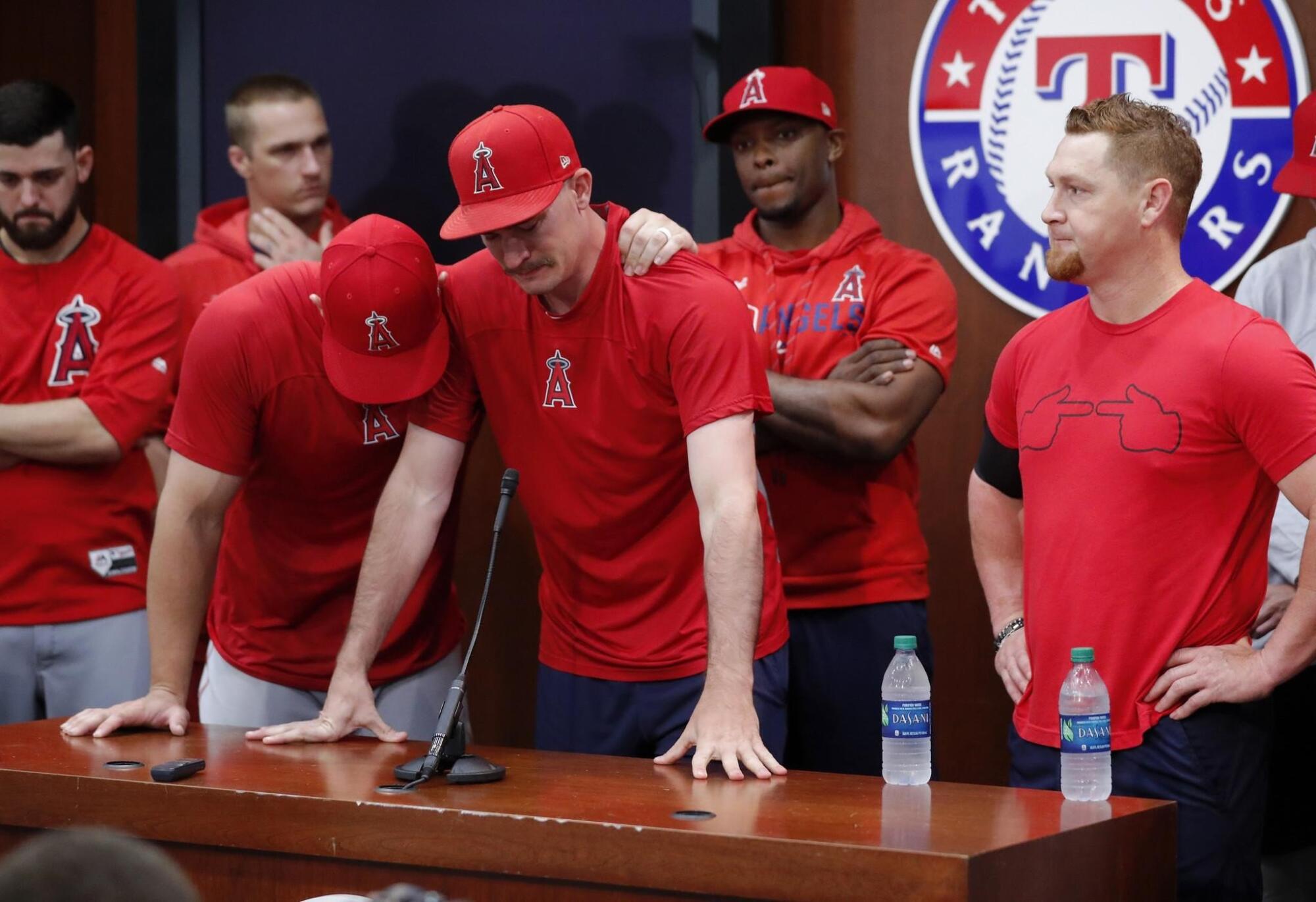
Angels’ Mike Trout, left, embraces Andrew Heaney, who fights back tears as he answers questions about their late friend and teammate Tyler Skaggs.
(Tony Gutierrez / Associated Press)
The night passes, followed by morning, and still no word from Skaggs. Heaney texts him: “Lunch?”
After a few minutes, Heaney stops by room 469. Light shines from under the door; the curtains must be open in there. Nearby, hotel workers are noisily cleaning a carpet. Heaney wonders how anyone could sleep through all this.
When his knock gets no response, he goes back to his room and tries calling Skaggs on the hotel phone.
1:49 p.m. CT
Tom Taylor, the Angels traveling secretary, is having lunch with Kay at a nearby barbecue joint and recalls Carli texting him. Heaney also reaches out to Taylor.
“He hadn’t heard from him either,” Taylor later testifies.
More than 12 hours after Carli’s last exchange with her husband, she messages again: “You have a drinking problem. I’m about to text tom Taylor.”
Carli later insists these words were sent “purely out of anger” with “no truth to it.”
Irritation gives way to another emotion. Carli contacts Skaggs’ mother, Hetman.
“She was really nervous,” Hetman later testifies. “I was really nervous because it was very unusual not to hear back from Tyler. Tyler was very good about returning text messages.” Hetman dials his number, and it sounds as if the call goes directly to voicemail. Her husband, Dan Ramos, sends a text:
“Hi kid. How r u doing. How is life treating u. How is your arm feeling”

A photo of Tyler Skaggs and his wife, Carli, is displayed outside a memorial service for the Angels pitcher in 2019.
(Christina House / Los Angeles Times)
2:04 p.m. CT
Now Hetman tries texting: “Hey Ty Are you okay today?”
Around the same time, Taylor returns to the hotel and knocks on Skaggs’ door. He then summons Chuck Knight, one of the team’s security men, and they ask hotel management to let them into room 469.
A former Anaheim Police Department officer, Knight enters the room alone, staying less than a minute. Taylor later recalls him emerging with “a shocked-looking face, almost like, it’s not good, what he saw.”
2:16 p.m. CT
Knight calls 911. Asked later about what he encountered in the room, he testifies: “I saw two legs hanging off the end of the bed in a position that I thought was unusual for someone that might be sleeping … I walked closer in an attempt to obtain a pulse. I reached down to grab his wrist and noticed that his skin was very cool to the touch. I did not obtain a pulse.”
Heaney, who is getting messages from Carli, returns to the hallway outside room 469. Taylor tells him: “It’s not good.”
“I knew what was going on, but his wife didn’t,” Heaney later testifies. “And she was texting me, so it was — I just felt like I wanted her to know what was going on.”
He decides not to answer.
A call crackles over the scanner: “Medic 4-1, truck 4-1 respond. Medical emergency, Hilton Southlake Town Square.” The dispatcher adds: “It’s gonna be … a possible death investigation. PD is arriving on scene now.”
A Southlake police officer finds Skaggs’ room looking mostly undisturbed — the bed still made, a backpack and another bag on the couch, unopened beers on the coffee table. There is a white, “almost chalky” substance on the desk. Skaggs’ cellphone lies near his head.
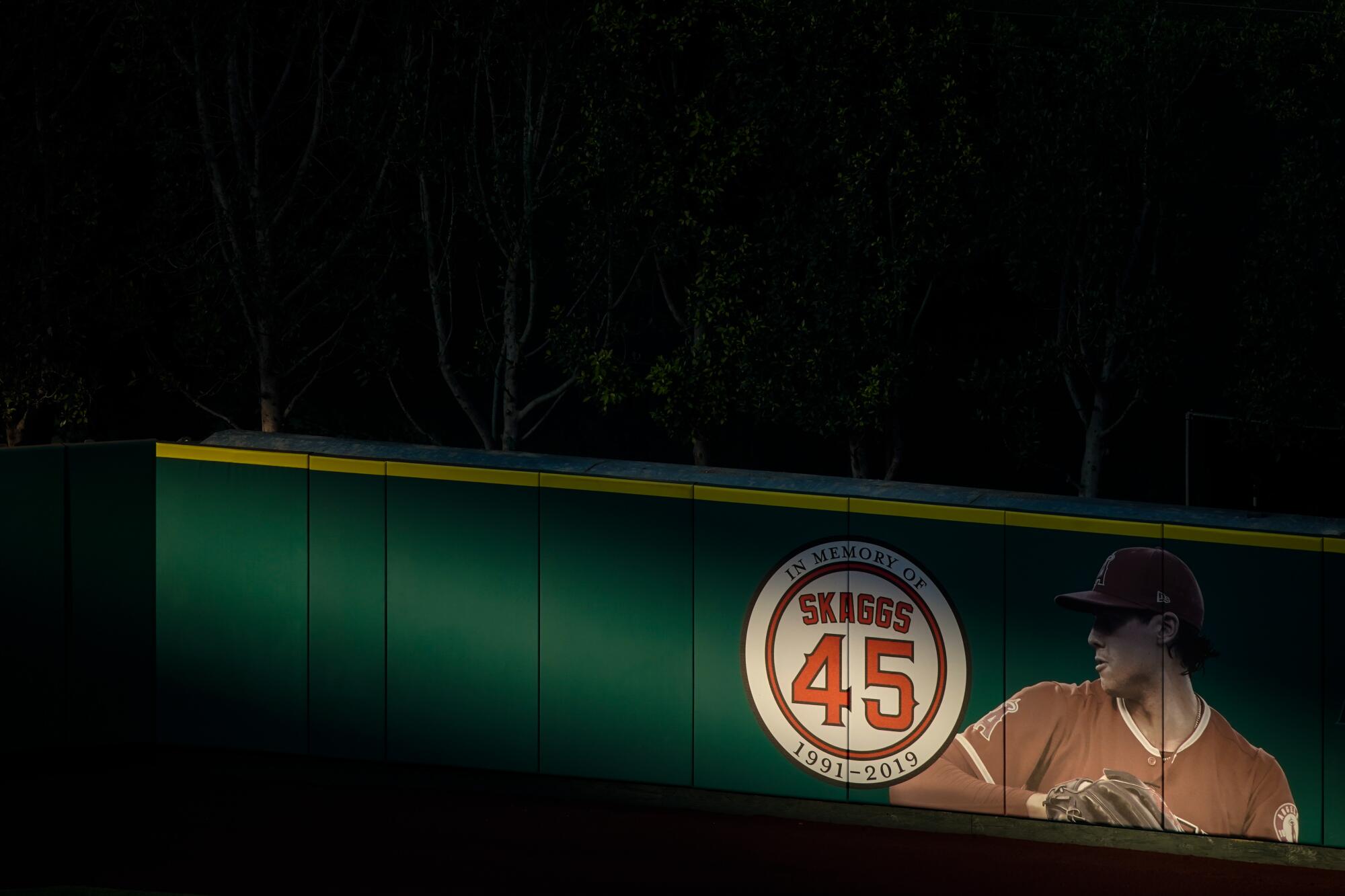
A memorial for Tyler Skaggs on the outfield wall at Angel Stadium.
(Los Angeles Times)
2:23 p.m. CT
Cory Teague, a Southlake Fire Department paramedic, arrives at room 469. His medical supplies include Naloxone, which can be administered to reverse the effects of opioid overdose.
“Did you use it?” a prosecutor later asks at trial.
“No.”
“Why not?”
“The patient had signs incompatible with life, unable to be revived.”
3:05 p.m. CT
Carli’s phone rings as she pulls up to her parents’ house in Santa Monica. It’s Billy Eppler, the Angels’ general manager. “I’ll never, ever forget that call,” she later says. She dials Hetman, who is at her Los Angeles home, and breaks the news. Hetman later recalls “crying and yelling and screaming.”
Buses are scheduled to take the Angels to their evening game. Instead, players and staff are told of Skaggs’ death and shepherded into a hotel banquet room where police take statements.
“The questions that we asked were generic for each player and employee,” Cpl. Delaney Green of the Southlake Police Department later testifies. “And it was along the lines of: When was the last time that you had seen or spoken to Tyler Skaggs? Had you seen him consume any alcohol on the plane? And did you know of any drug use that you were aware of?”
Kay is among those interviewed. He tells police that Skaggs was drinking on the flight to Texas but adds, “I didn’t think he had a lot.” He says he last saw the pitcher when they collected their room keys in the lobby.
3:52 p.m. CT
The Times and other news agencies report Skaggs’ death on social media. Family members call his mother at home. She later testifies that “before I could even talk to anybody, that whole — everything was like blowing up and it was super-crazy.”
4:11 p.m. CT
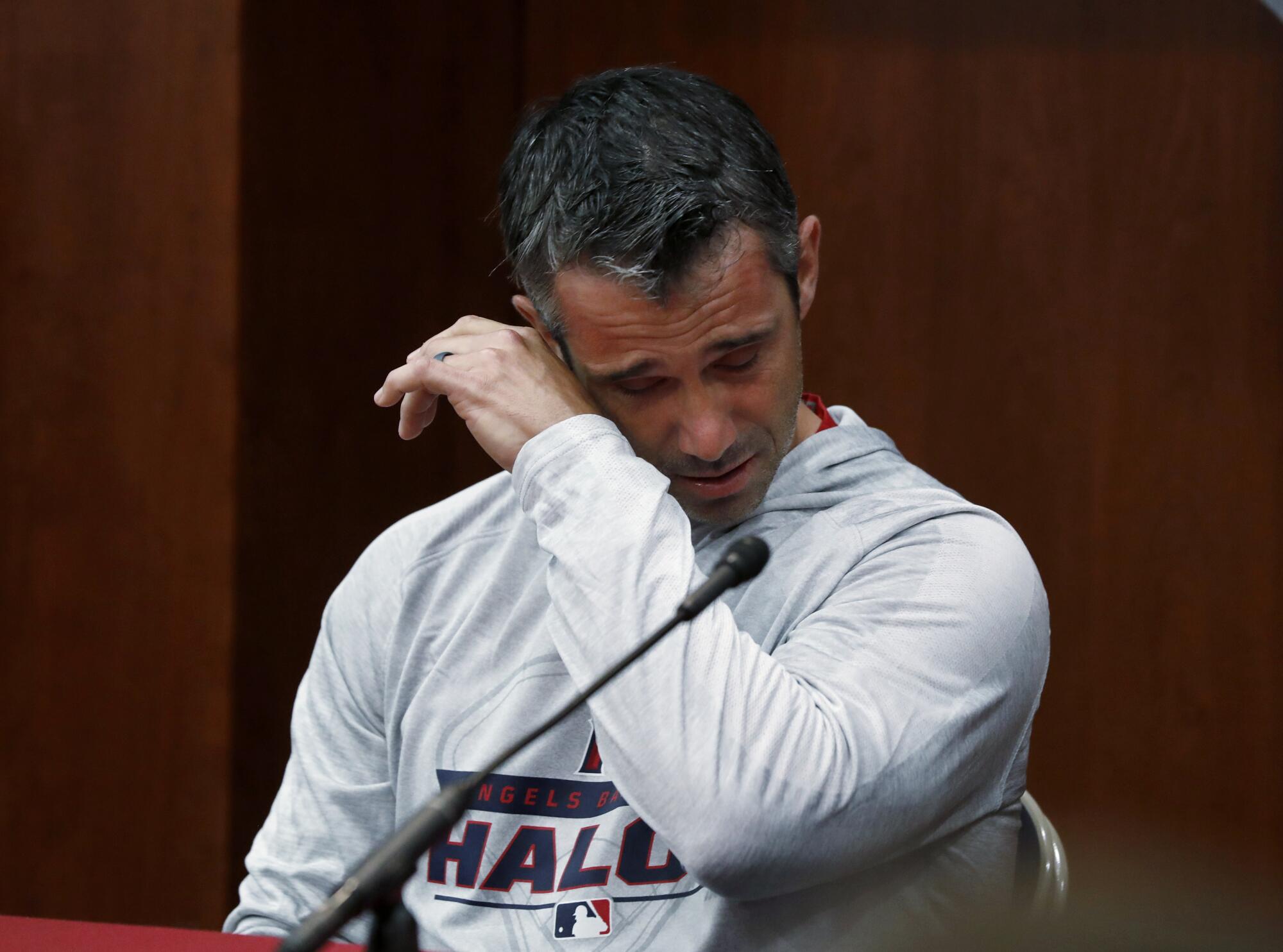
Angels manager Brad Ausmus speaks at a 2019 news conference about Tyler Skaggs’ death.
(Tony Gutierrez / Associated Press)
The Rangers announce the postponement of that night’s game as the Angels switch to another hotel. The team gathers for an emotional meeting. “We were able to talk about Tyler and laugh at some of the stories and some of the goofy things he did, listen to some of his music,” manager Brad Ausmus later says before breaking down.
On social media, players from around the league post messages.
“RIP to my longtime friend and Little League teammate,” then-St. Louis Cardinals pitcher Ryan Sherriff writes. “i love you brotha.”
About 8 p.m. CT
Carli and the Skaggs family board a flight to Texas.

About 10 a.m. CT
Carli and the Skaggs family visit the medical examiner’s office in Fort Worth. She later recalls kissing her husband’s cold lips as he lay on a gurney.
11:10 a.m. CT
The medical examiner begins an autopsy. He will eventually determine that “alcohol, fentanyl and oxycodone intoxication” caused Skaggs to choke on his own vomit.
Later that morning, Carli and the Skaggs family arrive at the Southlake police station to retrieve his luggage, iPad and other belongings.
In words that underscore the anguish of losing a loved one to opioids, Hetman later testifies: “I was angry because I knew that my son loved life and he did not want to die. He did not know that there was poison in that pill that cost him his life.”
About 5:30 p.m. CT
Team officials hold a news conference with Kay standing quietly to the side, hands clasped at his waist. At one point, he appears to take a deep breath, look toward the ceiling and exhale.
7:05 p.m. CT
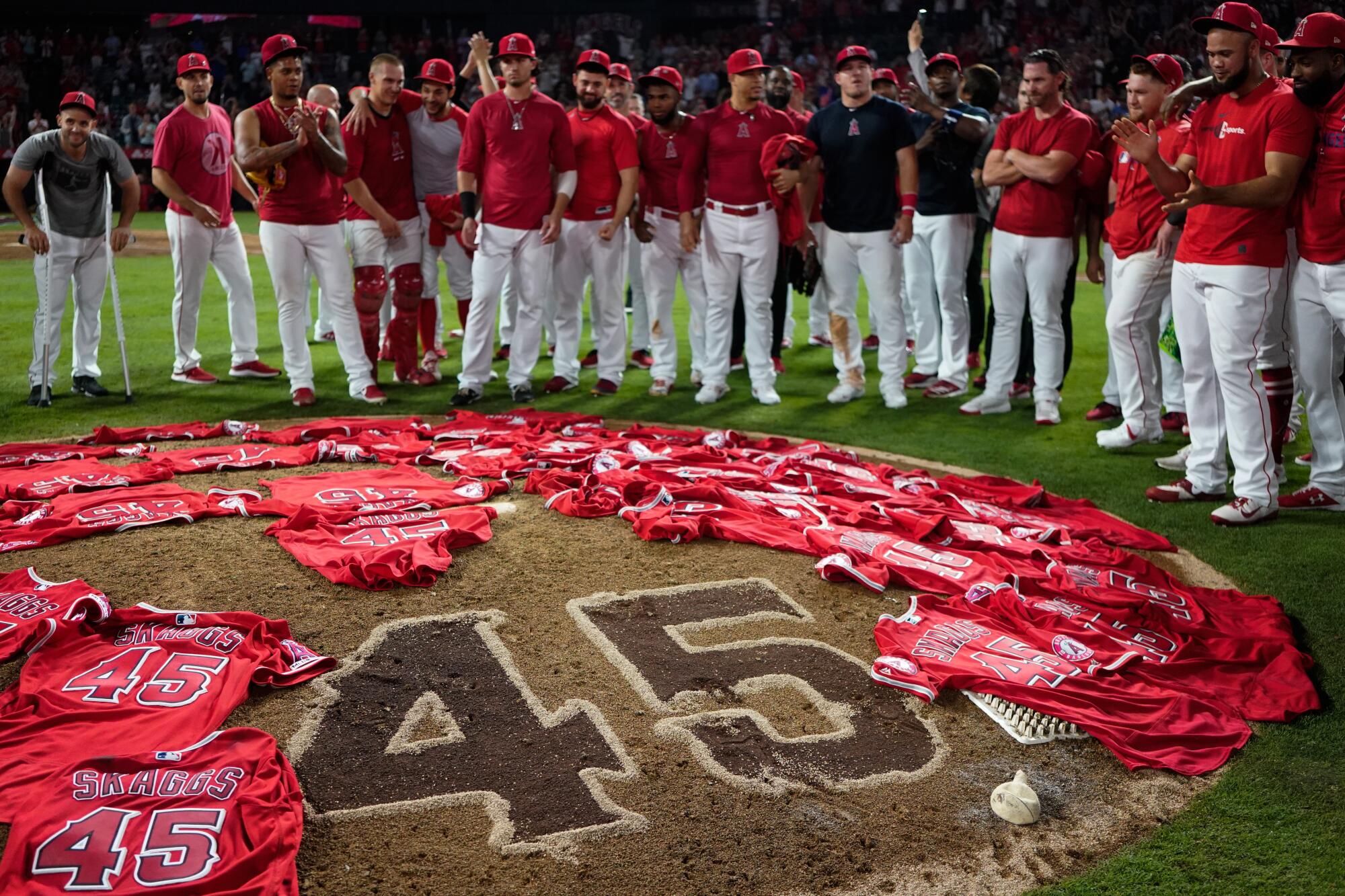
Teammates place jerseys with Tyler Skaggs’ number 45 on the mound at Angel Stadium at their first home game after his death.
(Kent Nishimura / Los Angeles Times)
The game against the Rangers proceeds as scheduled. The ballpark is eerily quiet, with the home team forgoing the usual walk-up music.
The Angels, wearing black No. 45 patches on their jerseys, score early and cruise to a surprising 9-4 victory, but Trout says: “All I was thinking about was Tyler. It was just a different feeling, you know. Just shock.”

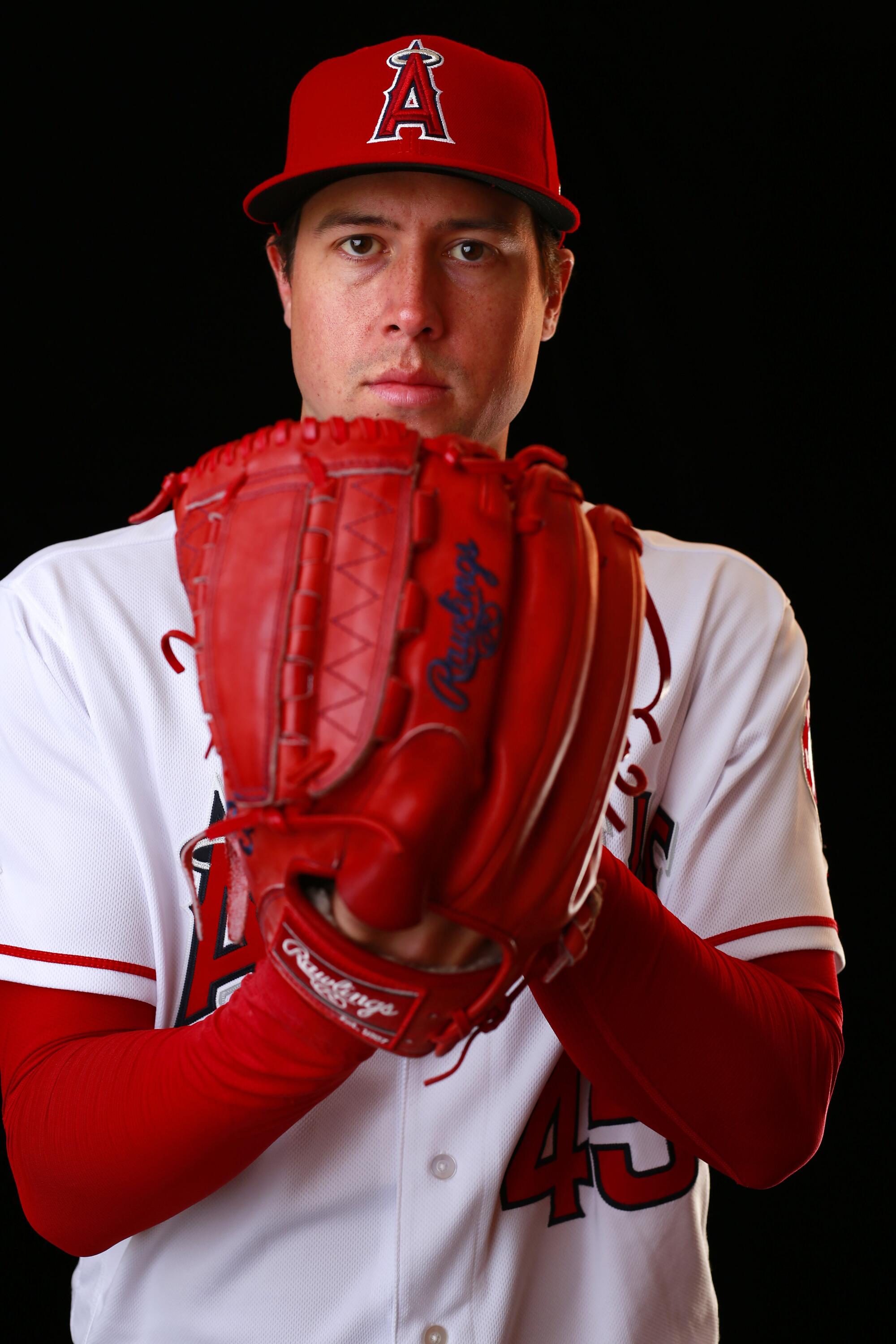
Angels pitcher Tyler Skaggs died of an overdose in a hotel room on July 1, 2019.
(K.C. Alfred/San Diego Union-Tribune)
Federal prosecutors charged Kay with distribution of a controlled substance resulting in death and conspiracy to possess with intent to distribute controlled substances. A trial began in February 2022.
“This was a case of one, one person who went up to that room on June 30,” a prosecutor said in court. “One person who went into that room and gave Tyler Skaggs fentanyl.”
The jury deliberated less than 90 minutes before returning a guilty verdict on both counts.
At a hearing where the judge sentenced him to 22 years in federal prison, Kay — who didn’t testify during trial — apologized to his family for the “disgrace and embarrassment” he had caused them.
Privately, however, he continued to profess innocence. In a recorded jailhouse call, he told a friend: “The worst thing, though, is that text that he sent me … because I didn’t know what he wanted. I had no idea. In my head, I think he thought I already got more [pills] for him but I told him they were going to be s—.”
By then, the Skaggs family had filed a wrongful-death suit against the Angels. The team has denied wrongdoing, and the case continues.
In the five years since Skaggs died, opioid overdoses — fueled by illicitly manufactured pills — have claimed hundreds of thousands of American lives.
The Substance Abuse and Mental Health Services Administration has a 24-hour helpline for individuals and families facing mental and substance abuse disorders. The number is (800) 662-HELP (4357).

Science
In search for autism’s causes, look at genes, not vaccines, researchers say

Earlier this year, Health and Human Services Secretary Robert F. Kennedy Jr. pledged that the search for autism’s cause — a question that has kept researchers busy for the better part of six decades — would be over in just five months.
“By September, we will know what has caused the autism epidemic, and we’ll be able to eliminate those exposures,” Kennedy told President Trump during a Cabinet meeting in April.
That ambitious deadline has come and gone. But researchers and advocates say that Kennedy’s continued fixation on autism’s origins — and his frequent, inaccurate claims that childhood vaccines are somehow involved — is built on fundamental misunderstandings of the complex neurodevelopmental condition.
Even after more than half a century of research, no one yet knows exactly why some people have autistic traits and others do not, or why autism spectrum disorder looks so different across the people who have it. But a few key themes have emerged.
Researchers believe that autism is most likely the result of a complex set of interactions between genes and the environment that unfold while a child is in the womb. It can be passed down through families, or originate with a spontaneous gene mutation.
Environmental influences may indeed play a role in some autism cases, but their effect is heavily influenced by a person’s genes. There is no evidence for a single trigger that causes autism, and certainly not one a child encounters after birth: not a vaccine, a parenting style or a post-circumcision Tylenol.
“The real reason why it’s complicated, the more fundamental one, is that there’s not a single cause,” said Irva Hertz-Picciotto, a professor of public health science and director of the Environmental Health Sciences Center at UC Davis. “It’s not a single cause from one person to the next, and not a single cause within any one person.”
Kennedy, an attorney who has no medical or scientific training, has called research into autism’s genetics a “dead end.” Autism researchers counter that it’s the only logical place to start.
“If we know nothing else, we know that autism is primarily genetic,” said Joe Buxbaum, a molecular neuroscientist who directs the Seaver Autism Center for Research and Treatment at the Icahn School of Medicine at Mount Sinai. “And you don’t have to actually have the exact genes [identified] to know that something is genetic.”
Some neurodevelopment disorders arise from a difference in a single gene or chromosome. People with Down syndrome have an extra copy of chromosome 21, for example, and Fragile X syndrome results when the FMR1 gene isn’t expressed.
Autism in most cases is polygenetic, which means that multiple genes are involved, with each contributing a little bit to the overall picture.
Researchers have found hundreds of genes that could be associated with autism; there may be many more among the roughly 20,000 in the human genome.
In the meantime, the strongest evidence that autism is genetic comes from studies of twins and other sibling groups, Buxbaum and other researchers said.
The rate of autism in the U.S. general population is about 2.8%, according to a study published last year in the journal Pediatrics. Among children with at least one autistic sibling, it’s 20.2% — about seven times higher than the general population, the study found.
Twin studies reinforce the point. Both identical and fraternal twins develop in the same womb and are usually raised in similar circumstances in the same household. The difference is genetic: identical twins share 100% of their genetic information, while fraternal twins share about 50% (the same as nontwin siblings).
If one fraternal twin is autistic, the chance that the other twin is also autistic is about 20%, or about the same as it would be for a nontwin sibling.
But if one in a pair of identical twins is autistic, the chance that the other twin is also autistic is significantly higher. Studies have pegged the identical twin concurrence rate anywhere from 60% to 90%, though the intensity of the twins’ autistic traits may differ significantly.
Molecular genetic studies, which look at the genetic information shared between siblings and other blood relatives, have found similar rates of genetic influence on autism, said Dr. John Constantino, a professor of pediatrics, psychiatry and behavioral sciences at the Emory University School of Medicine and chief of behavioral and mental health at Children’s Healthcare of Atlanta.
Together, he said, “those studies have indicated that a vast share of the causation of autism can be traced to the effects of genetic influences. That is a fact.”
Buxbaum compares the heritability of autism to the heritability of height, another polygenic trait.
“There’s not one gene that’s making you taller or shorter,” Buxbaum said. Hundreds of genes play a role in where you land on the height distribution curve. A lot of those genes run in families — it’s not unusual for very tall people, for example, to have very tall relatives.
But parents pass on a random mix of their genes to their children, and height distribution across a group of same-sex siblings can vary widely. Genetic mutations can change the picture. Marfan syndrome, a condition caused by mutations in the FBN1 gene, typically makes people grow taller than average. Hundreds of genetic mutations are associated with dwarfism, which causes shorter stature.
Then once a child is born, external factors such as malnutrition or disease can affect the likelihood that they reach their full height potential.
So genes are important. But the environment — which in developmental science means pretty much anything that isn’t genetics, including parental age, nutrition, air pollution and viruses — can play a major role in how those genes are expressed.
“Genetics does not operate in a vacuum, and at the same time, the impact of the environment on people is going to depend on a person’s individual genetics,” said Brian K. Lee, a professor of epidemiology and biostatistics at Drexel University who studies the genetics of developmental disorders.
Unlike the childhood circumstances that can affect height, the environmental exposures associated with autism for the most part take place in utero.
Researchers have identified multiple factors linked to increased risks of the disorder, including older parental age, infant prematurity and parental exposure to air pollution and industrial solvents.
Investigations into some of these linkages were among the more than 50 autism-related studies whose funding Kennedy has cut since taking office, a ProPublica investigation found. In contrast, no credible study has found links between vaccines and autism — and there have been many.
One move from the Department of Health and Human Services has been met with cautious optimism: even as Kennedy slashed funding to other research projects, the department in September announced a $50-million initiative to explore the interactions of genes and environmental factors in autism, which has been divided among 13 different research groups at U.S. universities, including UCLA and UC San Diego.
The department’s selection of well-established, legitimate research teams was met with relief by many autism scientists.
But many say they fear that such decisions will be an anomaly under Kennedy, who has repeatedly rejected facts that don’t conform to his preferred hypotheses, elevated shoddy science and muddied public health messaging on autism with inaccurate information.
Disagreements are an essential part of scientific inquiry. But the productive ones take place in a universe of shared facts and build on established evidence.
And when determining how to spend limited resources, researchers say, making evidence-based decisions is vital.
“There are two aspects of these decisions: Is it a reasonable expenditure based on what we already know? And if you spend money here, will you be taking money away from HHS that people are in desperate need of?” Constantino said. “If you’re going to be spending money, you want to do that in a way that is not discarding what we already know.”
Science
Contributor: New mothers are tempted by Ozempic but don’t have the data they need

My friend Sara, eight weeks after giving birth, left me a tearful voicemail. I’m a clinical psychologist specializing in postpartum depression and psychosis, but mental health wasn’t Sara’s issue. Postpartum weight gain was.
Sara told me she needed help. She’d gained 40 pounds during her pregnancy, and she was still 25 pounds overweight. “I’m going back to work and I can’t look like this,” she said. “I need to take Ozempic or something. But do you know if it’s safe?”
Great question. Unfortunately researchers don’t yet have an answer. On Dec. 1, the World Health Organization released its first guidelines on the use of GLP-1 receptor agonists such as Ozempic, generically known as semaglutide. One of the notable policy suggestions in that report is to not prescribe GLP-1s to pregnant women. Disappointingly, the report says nothing about the use of the drug by postpartum women, including those who are breastfeeding.
There was a recent Danish study that led to medical guidelines against prescribing to patients who are pregnant or breastfeeding.
None of that is what my friend wanted to hear. I could only encourage her to speak to her own medical doctor.
Sara’s not alone. I’ve seen a trend emerging in my practice in which women use GLP-1s to shed postpartum weight. The warp speed “bounce-back” ideal of body shapes for new mothers has reemerged, despite the mental health field’s advocacy to abolish the archaic pressure of martyrdom in motherhood. GLP-1s are being sold and distributed by compound pharmacies like candy. And judging by their popularity, nothing tastes sweeter than skinny feels.
New motherhood can be a stressful time for bodies and minds, but nature has also set us up for incredible growth at that moment. Contrary to the myth of spaced-out “mommy brains,” new neuroplasticity research shows that maternal brains are rewired for immense creativity and problem solving.
How could GLP-1s affect that dynamic? We just don’t know. We do know that these drugs are associated with changes far beyond weight loss, potentially including psychiatric effects such as combating addiction.
Aside from physical effects, this points to an important unanswered research question: What effects, if any, do GLP-1s have on a woman’s brain as it is rewiring to attune to and take care of a newborn? And on a breastfeeding infant? If GLP-1s work on the pleasure center of the brain and your brain is rewiring to feel immense pleasure from a baby coo, I can’t help but wonder if that will be dampened. When a new mom wants a prescription for a GLP-1 to help shed baby weight, her medical provider should emphasize those unknowns.
These drugs may someday be a useful tool for new mothers. GLP-1s are helping many people with conditions other than obesity. A colleague of mine was born with high blood pressure and cholesterol. She exercised every day and adopted a pescatarian diet. Nothing budged until she added a GLP-1 to her regimen, bringing her blood pressure to a healthy 120/80 and getting cholesterol under control. My brother, an otherwise healthy young man recently diagnosed with a rare idiopathic lymphedema of his left leg, is considering GLP-1s to address inflammation and could be given another chance at improving his quality of life.
I hope that GLP-1s will continue to help those who need it. And I urge everyone — especially new moms — to proceed with caution. A healthy appetite for nutritious food is natural. That food fuels us for walks with our dogs, swims along a coastline, climbs through leafy woods. It models health and balance for the young ones who are watching us for clues about how to live a healthy life.
Nicole Amoyal Pensak, a clinical psychologist and researcher, is the author of “Rattled: How to Calm New Mom Anxiety With the Power of the Postpartum Brain.”
Science
California issues advisory on a parasitic fly whose maggots can infest living humans

A parasitic fly whose maggots can infest living livestock, birds, pets and humans could threaten California soon.
The New World Screwworm has rapidly spread northward from Panama since 2023 and farther into Central America. As of early September, the parasitic fly was present in seven states in southern Mexico, where 720 humans have been infested and six of them have died. More than 111,000 animals also have been infested, health officials said.
In early August, a person traveling from El Salvador to Maryland was discovered to have been infested, federal officials said. But the parasitic fly has not been found in the wild within a 20-mile radius of the infested person, which includes Maryland, Virginia and the District of Columbia.
After the Maryland incident, the California Department of Public Health decided to issue a health advisory this month warning that the New World Screwworm could arrive in California from an infested traveler or animal, or from the natural travel of the flies.
Graphic images of New World Screwworm infestations show open wounds in cows, deer, pigs, chickens, horses and goats, infesting a wide swath of the body from the neck, head and mouth to the belly and legs.
The Latin species name of the fly — hominivorax — loosely translates to “maneater.”
“People have to be aware of it,” said Dr. Peter Chin-Hong, a UC San Francisco infectious diseases specialist. “As the New World Screwworm flies northward, they may start to see people at the borders — through the cattle industry — get them, too.”
Other people at higher risk include those living in rural areas where there’s an outbreak, anyone with open sores or wounds, those who are immunocompromised, the very young and very old, and people who are malnourished, the U.S. Centers for Disease Control and Prevention says.
There could be grave economic consequences should the New World Screwworm get out of hand among U.S. livestock, leading to animal deaths, decreased livestock production, and decreased availability of manure and draught animals, according to the U.S. Department of Agriculture.
“It is not only a threat to our ranching community — but it is a threat to our food supply and our national security,” the USDA said.
Already, in May, the USDA suspended imports of live cattle, horse and bison from the Mexican border because of the parasitic fly’s spread through southern Mexico.
The New World Screwworm isn’t new to the U.S.
But it was considered eradicated in the United States in 1966, and by 1996, the economic benefit of that eradication was estimated at nearly $800 million, “with an estimated $2.8 billion benefit to the wider economy,” the USDA said.
Texas suffered an outbreak in 1976. A repeat could cost the state’s livestock producers $732 million a year and the state economy $1.8 billion, the USDA said.
Historically, the New World Screwworm was a problem in the U.S. Southwest and expanded to the Southeast in the 1930s after a shipment of infested animals, the USDA said. Scientists in the 1950s discovered a technique that uses radiation to sterilize male parasitic flies.
Female flies that mate with the sterile male flies produce sterile eggs, “so they can’t propagate anymore,” Chin-Hong said. It was this technique that allowed the U.S., Mexico and Central America to eradicate the New World Screwworm by the 1960s.
But the parasitic fly has remained endemic in South America, Cuba, Haiti and the Dominican Republic.
In late August, the USDA said it would invest in new technology to try to accelerate the pace of sterile fly production. The agency also said it would build a sterile-fly production facility at Edinburg, Texas, which is close to the Mexico border, and would be able to produce up to 300 million sterile flies per week.
“This will be the only United States-based sterile fly facility and will work in tandem with facilities in Panama and Mexico to help eradicate the pest and protect American agriculture,” the USDA said.
The USDA is already releasing sterile flies in southern Mexico and Central America.
The risk to humans from the fly, particularly in the U.S., is relatively low. “We have decent nutrition; people have access to medical care,” Chin-Hong said.
But infestations can happen. Open wounds are a danger, and mucus membranes can also be infested, such as inside the nose, according to the CDC.
An infestation occurs when fly maggots infest the living flesh of warm-blooded animals, the CDC says. The flies “land on the eyes or the nose or the mouth,” Chin-Hong said, or, according to the CDC, in an opening such as the genitals or a wound as small as an insect bite. A single female fly can lay 200 to 300 eggs at a time.
When they hatch, the maggots — which are called screwworms — “have these little sharp teeth or hooks in their mouths, and they chomp away at the flesh and burrow,” Chin-Hong said. After feeding for about seven days, a maggot will fall to the ground, dig into the soil and then awaken as an adult fly.
Deaths among humans are uncommon but can happen, Chin-Hong said. Infestation should be treated as soon as possible. Symptoms can include painful skin sores or wounds that may not heal, the feeling of the larvae moving, or a foul-smelling odor, the CDC says.
Patients are treated by removal of the maggots, which need to be killed by putting them into a sealed container of concentrated ethyl or isopropyl alcohol then disposed of as biohazardous waste.
The parasitic fly has been found recently in seven Mexican states: Campeche, Chiapas, Oaxaca, Quintana Roo, Tabasco, Veracruz, and Yucatán. Officials urge travelers to keep open wounds clean and covered, avoid insect bites, and wear hats, loose-fitting long-sleeved shirts and pants, socks, and insect repellents registered by the Environmental Protection Agency as effective.
-

 Alaska6 days ago
Alaska6 days agoHowling Mat-Su winds leave thousands without power
-

 Politics1 week ago
Politics1 week agoTrump rips Somali community as federal agents reportedly eye Minnesota enforcement sweep
-
Ohio1 week ago
Who do the Ohio State Buckeyes hire as the next offensive coordinator?
-

 Texas6 days ago
Texas6 days agoTexas Tech football vs BYU live updates, start time, TV channel for Big 12 title
-

 News1 week ago
News1 week agoTrump threatens strikes on any country he claims makes drugs for US
-

 World1 week ago
World1 week agoHonduras election council member accuses colleague of ‘intimidation’
-

 Washington3 days ago
Washington3 days agoLIVE UPDATES: Mudslide, road closures across Western Washington
-

 Iowa5 days ago
Iowa5 days agoMatt Campbell reportedly bringing longtime Iowa State staffer to Penn State as 1st hire




















